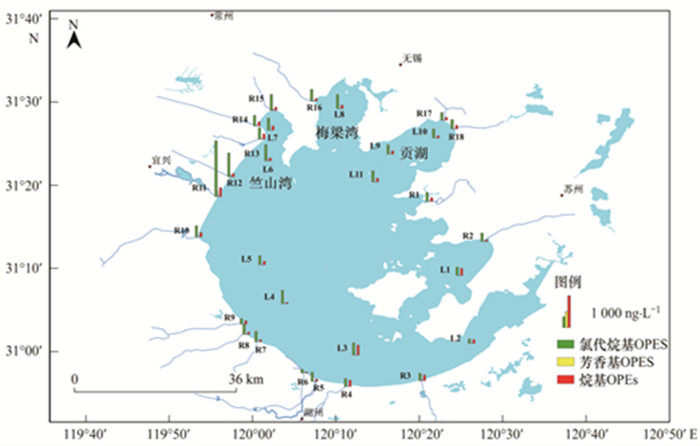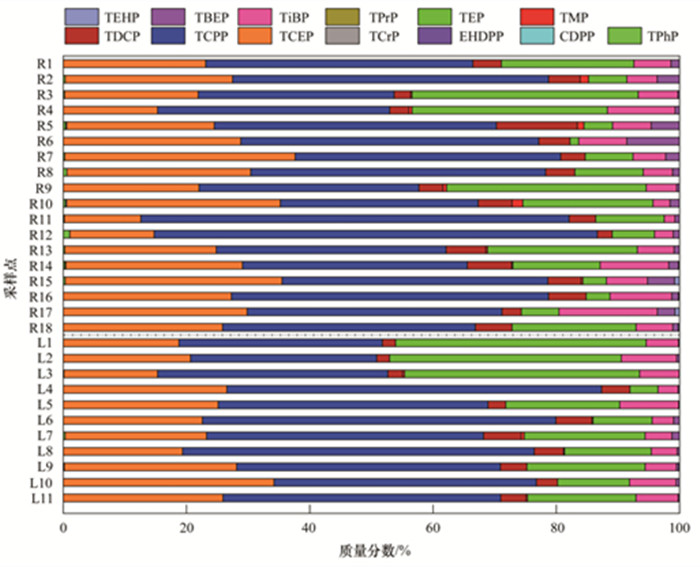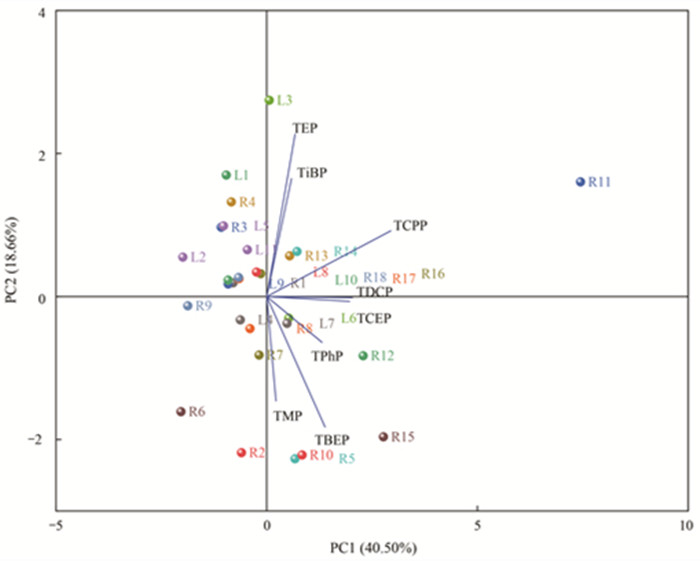2. 中国环境科学研究院, 国家环境保护化学品生态效应与风险评估重点实验室, 北京 100012
2. State Environmental Protection Key Laboratory of Ecological Effect and Risk Assessment of Chemicals, Chinese Research Academy of Environmental Sciences, Beijing 100012, China
有机磷酸酯(organophosphate esters, OPEs)是一类人工合成的磷酸衍生物, 因其具有良好的阻燃性和增塑性而被用作阻燃剂和增塑剂, 广泛添加到涂料、纺织品、电子器件和建筑材料等产品中[1, 2].按取代基的不同可将OPEs分为烷基磷酸酯、氯代烷基磷酸酯和芳香基磷酸酯, 其中氯代烷基磷酸酯主要用作阻燃剂[3], 烷基磷酸酯和芳香基磷酸酯用作增塑剂, 兼具阻燃作用, 一些非氯代烷基磷酸酯还可用作液压油、车用机油等的耐磨剂等[4, 5].近年来, 作为多溴联苯醚(PBDE)主要替代品的OPEs的生产量和使用量逐年增加[6, 7].据报道, 全球OPEs消费量从2007年的70 000 t增长到2015年的680 000 t[8, 9], 而中国OPEs的消费量在2011年达100 000 t, 并以每年15%的速率增长[10].由于OPEs是以非化学键方式添加到各种产品中的, 在产品的生产、使用和弃置过程中极易直接或间接地释放到环境中[11], 甚至有可能通过长距离大气输送到达极地地区[8].目前在多种环境介质中都有OPEs的检出, 如大气、灰尘[12]、土壤[13]、沉积物[3]、河流[14]、湖泊[15]以及水生生物[16], 甚至在食品[17]、人体指甲、头发[18]、母乳[19]和尿液[20]中也有检出.
相关研究表明, OPEs具有神经毒性、免疫毒性、致癌性和内分泌干扰性等[7, 9], 如磷酸三(1, 3-二氯-2-丙基)酯(TDCP)、磷酸三正丁酯(TnBP)和磷酸三苯酯(TPhP)具有神经毒性[21], 磷酸三(2-氯乙基)酯(TCEP)和磷酸三(1-氯-2-丙基)酯(TCPP)被认为是潜在的致癌物[22].OPEs因其对生态环境和人体造成的潜在危害而引起广泛关注, 欧盟在2014年第一次规定儿童玩具中TCEP、TDCP和TCPP的含量不得高于5 mg ·kg-1, 并于2015年禁止了TCEP的使用, 文献[23]中TCEP和TPhP被列为优先进行风险评估的化学品.OPEs可通过产品的损耗、泄漏和大气沉降等途径直接进入地表水, 此外, 由于污水处理厂对OPEs的去除效果不佳[24], 污水处理厂出水也成为地表水中OPEs的主要来源之一[25].一项针对欧洲各国污水处理厂水质情况的调查显示, 大多数污水处理厂的出水中可以检出TCPP和TCEP, 其浓度维持在几百个ng ·L-1, 并且TCPP具有难降解的特性[26].进入水体中的OPEs成为水资源重复利用的巨大障碍.由于大部分OPEs具有持久性[8], 地表水环境中OPEs的持续输入会对人体健康和生态系统构成潜在危害.
太湖位于我国经济最发达的地区之一, 是我国第三大淡水湖, 水域面积达2 338.1 km2, 湖岸线全长达393.2 km.太湖是我国重要的水产养殖基地、饮用水水源地, 兼具灌溉和航运等功能.太湖跨江、浙、皖、沪三省一市, 毗邻苏州、湖州、宜兴、常州和无锡, 周边城市常住人口达2 600多万, 经济社会发展迅速, 特别是西北部地区工业发达.而太湖作为周边地区的主要受纳水体, 长期承受着较大的环境污染压力.已有相关研究报道了太湖中心水体和沉积物中OPEs的污染情况[27~29], 但针对太湖环湖河流OPEs的污染情况和来源解析鲜见报道, 此外, 太湖作为饮用水水源地, OPEs的存在对周边居民的健康可能存在一定的风险.本研究选择18条环湖河流及太湖水体为研究对象, 分析了13种OPEs在太湖流域的污染水平及分布特征, 探究不同OPEs的相关性及其可能的来源.并采用商值法从生态和人体健康两方面综合评估了OPEs在该地区的风险, 以期为了解OPEs在太湖流域地表水中的污染状况和来源提供了数据支撑, 对改善太湖流域生态系统及居住人群的健康具有重要意义.
1 材料与方法 1.1 试剂与仪器13种OPEs标准品, 包括6种烷基磷酸酯:磷酸三甲酯(TMP)、磷酸三乙酯(TEP)、磷酸三丙酯(TPrP)、磷酸三异丁酯(TiBP)、磷酸三(2-乙基己基)酯(TEHP)和磷酸三丁氧乙基酯(TBEP), 3种氯代烷基磷酸酯:TCEP、TCPP和TDCP, 以及4种芳香基磷酸酯:TPhP、磷酸甲苯二苯酯(CDPP)、2-乙基己基二苯基磷酸酯(EHDPP)和磷酸三甲苯酯(TCrP), 各物质的理化性质列于表 1.除TiBP外, 均购自德国Dr. Ehremstorfer公司(纯度≥98%).TiBP与氘代物TnBP-d27、TCPP-d18购自加拿大Toronto Research Chemicals公司, TPrP-d21购自挪威Chiron AS公司, 氨水(25% ~28%)和盐酸(分析纯)购自国药集团化学试剂有限公司(北京), 甲醇和乙腈(色谱纯)购自英国Fisher公司, 甲酸(FA)购自美国Sigma-Aldrich公司.
|
|
表 1 OPEs的名称及理化性质 Table 1 Name and physicochemical properties of OPEs |
1.2 样品采集与前处理
样品采集于2019年6月, 共布设29个采样点, 包括环太湖18条环湖河流(R1~R18)以及11个太湖湖心采样点(L1~L11), 具体采样点的位置参见图 1.使用不锈钢采水器取1 L水样(0~1 m)于棕色玻璃瓶中, 冷藏运回实验室, 24 h内处理分析.

|
图 1 太湖流域水体有机磷酸酯的空间分布示意 Fig. 1 Spatial distribution of OPEs in Taihu Lake |
样品前处理及测定参照课题组前期工作[30], 量取500 mL水样过0.45 μm的玻璃纤维滤膜, 加入5 ng混合内标(TnBP-d27、TCPP-d18和TPrP-d21), 用ENVI-18固相萃取柱富集, 依次用5 mL二氯甲烷、5 mL乙腈和10 mL超纯水活化, 以1 mL ·min-1的流速上样, 水样富集后抽干10 min, 用10 mL超纯水淋洗, 继续抽真空1 h至萃取柱充分干燥, 8 mL二氯甲烷∶乙腈(体积比为1 ∶3)溶液洗脱, 收集洗脱液在40℃水浴中, 氮气吹至近干, 初始流动相比例定容至1 mL, 过0.22 μm的尼龙滤膜, 待UPLC-MS/MS分析.
1.3 样品分析使用超高效液相色谱-电喷雾离子源-串联三重四极杆质谱仪(Xevo T-QS, Waters, MA, USA)定量分析水样中的OPEs, 液相色谱柱为ACQUITY UPLC® BEH C18(1.7 μm, 50×2.1 mm, Waters, MA, USA).采用多反应监测(multiple reaction monitoring, MRM)与电喷雾正离子源(ESI+)模式.进样体积为5 μL, 流速0.4 mL ·min-1, 柱温40℃, 流动相为0.1%的甲酸水(A)和乙腈(B), 梯度洗脱程序为:0~1 min 2% B, 1.1 min 30% B, 2.5 min 55% B, 6.5 min 65% B, 7.2~8.9 min 98% B, 9~10 min 2% B.脱溶剂和雾化气体为氮气, 脱溶温度和离子源温度分别为150℃和400℃, 碰撞气为氦气, 毛细管电压为0.5 kV.
1.4 质量控制与质量保证采用内标法定量, 线性范围为0.1~200 μg ·L-1, 各物质标准曲线的R2>0.99.样品前处理和分析过程中所用玻璃器皿均依次用自来水和去离子水冲洗并烘干, 使用前用甲醇和乙腈润洗3次, 并设置了基质空白和实验室空白.地表水中13种OPEs的加标回收率范围为89.7% ~107.9%.所有水样中均加入TnBP-d27、TCPP-d18和TPrP-d21校正目标化合物的回收率和基质效应, 3种内标的回收率分别为(95.3±9.9)%、(101.6±5.9)%和(67.4±23.1)%.各OPEs在地表水中的检测限(LOD, S/N=3)在0.1~0.7 ng ·L-1之间, 方法定量限(LOQ, S/N=10) 在0.3~2.5 ng ·L-1之间.
1.5 风险评估 1.5.1 生态风险评估根据欧洲技术指南(European technical guidance document, TGD), 采用商值法(hazard quotient, HQ)评估太湖水体及环湖河流OPEs的生态风险, 计算公式如下:

|
式中, EC(environmental concentration)为环境中污染物的测量浓度, mg ·L-1; PNEC(predicted no effect concentration)为对应目标化合物的预测无效应浓度, mg ·L-1; L(E)C50为供试生物的半数致死(效应)浓度, 由查阅的相关研究获得[31~33]; AF(assessment factor)为评价因子, 根据欧盟水框架指令AF取1000.HQ<0.01时表明无生态风险, 0.01≤HQ<0.1时有较低的生态风险, 0.1≤HQ<1, 表明有中等生态风险, 当HQ≥1, 生态风险较高.
1.5.2 健康风险评估太湖作为重要的饮用水水源地, 饮用水的摄入是周边地区人群暴露OPEs的可能途径之一, 因此基于饮用水摄入评估OPEs对周边居民的健康风险具有重要意义, 具体计算公式如下[34]:

|
式中, ADD表示饮用水中OPEs的单位体重日摄入量[以bw计, ng ·(kg ·d)-1]; c表示饮用水中某种OPEs的浓度(ng ·L-1); IR表示日均总饮水摄入量(L ·d-1); AP表示饮水吸收率, 这里取100%; BW为体重(kg)
采用商值法评估饮用水中单个污染物暴露的暴露风险, 公式如下:

|
HQ<1表明暴露风险较小或忽略不计; 当HQ>1时, 则表明具有潜在的暴露风险.
1.6 数据处理采用SPSS 22.0进行统计学分析, 采用OriginPro 2016作图.为满足统计需求, 将低于LOQ的OPEs的浓度定为1/2 LOQ, 通过Shapiro-Wilk检验判定数据是否符合正态分布, Mann-Whitney检验验证OPEs在太湖水体和环湖河流中的差异性, 采用Spearman相关分析和主成分分析(PCA)探讨OPEs的来源.ArcGIS 10.2用于绘制OPEs的空间分布.
2 结果与讨论 2.1 太湖水体及环湖河流中OPEs的浓度及组成太湖水体及环湖河流中OPEs的浓度及检出频率如表 2所示, 除TPrP、EHDPP和TCrP未检出外, 其余10种OPEs在所有采样点水样中均有不同程度的检出, TMP、TEHP、TPhP和CDPP的检出率分别为48.28%、20.69%、44.83%和13.79%, 其余6种OPEs的检出率为100%, 表明OPEs在太湖水体及环湖河流中广泛存在.ΣOPEs的浓度范围为152.5~2 524 ng ·L-1, 浓度中值为519.2 ng ·L-1.较2016年检测结果[35](100~1 700 ng ·L-1), 太湖水体ΣOPEs升高, 这说明近年来太湖周边OPEs的使用量和排放量逐年增加.
|
|
表 2 13种OPEs的检测限(LOD)、定量限(LOQ)、检出率、加标回收率以及检测浓度1) Table 2 Detection limits(LOD), quantitative limits(LOQ), detection rates, recoveries, and concentrations of 13 OPEs |
太湖流域ΣOPEs的浓度显著高于我国沿海地区, 如青岛海湾(75.8 ng ·L-1)[36]、渤海入海河流(300 ng ·L-1)[10]、连云港(392.1 ng ·L-1)、北部湾水产养殖区(91.8 ng ·L-1)[37]及珠江入海口(198.5 ng ·L-1)[6], 这可能是开阔海域对OPEs的稀释作用会影响其在水环境中的浓度水平.但与一些大城市相比, 如北京城市河流(954 ng ·L-1)[38]、上海市地表水(850.2 ng ·L-1)[39]、成都锦江(3 747.9 ng ·L-1)[40]和美国纽约(1 250 ng ·L-1)[12], 城市地表水中的ΣOPEs的浓度要远高于太湖流域, 但法国罗纳河水体(142.0 ng ·L-1)[14]以及西班牙城市河流(230 ng ·L-1)[41]的ΣOPEs的浓度低于太湖流域, 这可能与不同地区使用含OPEs产品的多少或生活污水的排放量有关.重庆市万州县农业地区河流中ΣOPEs的浓度最低(浓度范围为24.5~68ng ·L-1), 该样品采集于农业地区, 远离市区和工厂, OPEs的污染较轻[42].检出的10种OPEs中, TCPP和TCEP是最主要的OPEs, 与海河、渤海入海河流、上海市地表水等水体中检测到的结果吻合, 其检出浓度分别为73.7~1 753.9 ng ·L-1和43.9~313.5 ng ·L-1, 浓度中值分别为204.6 ng ·L-1和131.3ng ·L-1.TCPP和TCEP主要作为阻燃剂应用于聚氨酯泡沫、纺织品和橡胶中, 且TCPP由于成本低且阻燃性能好[22], 是全球产量最高的OPEs, 太湖流域周边工业企业密集, TCPP的使用量大[27].TCEP在工业混合物V6(主要应用于汽车内饰和屋内装饰)中作为一种伴生添加剂存在, 在太湖流域检测到高浓度的TCPP和TCEP, 与周边城市发达的纺织、电子和橡胶等制造业有关.此外, TEP在太湖流域水体中的浓度也较高, 占ΣOPEs的1.40%~40.66%.TEP是工业用品中用量较大的一类烷基磷酸酯, 主要用作纤维素、不饱和树脂的增塑剂, 且TEP的半衰期较长, 在环境中比较稳定, 因此在水体中有较高占比.
由图 2可知, 氯代烷基磷酸酯是浓度最高的一类OPEs, Σ(TCPP+TCEP+TDCP)的浓度范围为124.2~2 176 ng·L-1, 占ΣOPEs的62.95%~91.95%, 烷基磷酸酯次之, 浓度最低的是芳香基磷酸酯, 这与Shi等人[6]在珠江口水域的研究结果一致.一方面这与三类有机磷酸酯的使用量相关.另一方面, 氯代烷基磷酸酯本身化学性质稳定, 在各种环境介质中都不易降解, 污水处理厂对氯代烷基磷酸酯的去除率较低[43].此外, 光降解是地表水中OPEs消除的主要原因, 而芳香基磷酸酯比烷基磷酸酯和氯代烷基磷酸酯更易光降解, 这也是氯代烷基磷酸酯占比最高的原因之一[44].

|
图 2 太湖水体及环湖河流有机磷酸酯的组成特征 Fig. 2 Composition of OPEs in the surface water of Taihu Lake |
OPEs在太湖流域水体中的空间分布如图 1所示.18条环湖河流中, 北部和西部沿岸入湖河流是OPEs浓度最高的地区, 其中位于西北部的R11(大浦河)OPEs浓度最高, ΣOPEs为2 524 ng ·L-1, 该采样点靠近我国最大的有机磷阻燃剂工厂——雅克科技[27], 大量含OPEs的工业废水的排放可能是大浦河中OPEs浓度较高的原因.西北部入湖河流上游是宜兴市、常州市和无锡市, 这些地区城市化进程快速, 工业发达, 分布着众多的印刷企业、电子加工企业和纺织企业, 有机磷酸酯的使用量较大, 进入环境中的OPEs多.此外, 竺山湾和梅梁湾水域相对封闭, 水与外界湖体交换作用小, 水体自净能力差, OPEs污染较为严重.南太湖沿岸河流的OPEs浓度较西部和北部低, 浓度范围为152.5~530.5 ng ·L-1, 位于太湖南部的R6(环渚溪)的检出浓度最低.南太湖周边城市为湖州市, 和宜兴、常州市相比, 该市经济发展相对较慢, 人口较少, 工业少, 有机磷酸酯的生产和使用量少.同时, 南部湖区湖岸线开阔, 为典型的圆弧形岸线, 水流交换作用快, 水体自净作用强, 这也加快了OPEs在该区域的迁移.东部河流采样点位R1~R3的ΣOPEs浓度范围为250.2~587.5 ng ·L-1.采样点位R2位于胥江, 胥江是太湖的出湖河流之一, 河水水质较好, 因此胥江江口的稀释作用可能是R2点位OPEs较低的原因之一.
通过Mann-Whitney U检验可知, 除TBEP外, 太湖湖心水体和环湖河流中的各OPEs以及ΣOPEs的浓度无显著性差异, 湖心水体ΣOPEs的浓度中值(545.6 ng ·L-1)略高于环湖河流(456.2 ng ·L-1).太湖湖心水体OPEs主要来源是入湖河流, 11个分布在太湖湖心的采样点中, 位于南太湖的L3浓度最高, 为862.5 ng ·L-1, 且高于南太湖沿岸入湖河流, 浓度最低的采样点位于东太湖(L2, 313.6 ng ·L-1).由图 1可以看出, 湖心水体ΣOPEs的差异不明显, 这可能与水体的稀释和流动作用有关.
2.3 OPEs的源解析剔除检出率较低的TEHP和TDCP, 太湖流域水体和环湖河流中OPEs的相关性分析如表 3所示.TCPP、TCEP和TDCP的相关性较强(P<0.01), 三者均为氯代烷基磷酸酯, 表明其可能来自同一种源, 而且氯代烷基磷酸酯在环境中不易降解, 在各种环境介质中均有较高的检出浓度, 这与Niu等[45]在海河流域水体中的发现一致.TPhP和TBEP、TCEP以及TDCP有较为显著的相关性(P<0.01), 表明其可能具有同源性.
|
|
表 3 太湖水体及环湖河流中OPEs的相关性分析1) Table 3 Relevance of OPEs in Taihu Lake |
为明确太湖流域水体中OPEs的可能来源, 采用PCA做进一步分析, 结果如图 3所示.分析得到两个主成分(PC1和PC2), 对总方差的贡献率分别为40.50%和18.66%.各个OPEs对PC1都有一定的载荷, 主要对应于TCPP、TCEP和TDCP, 反映和氯代烷基磷酸酯相关的排放源, 这与相关性分析结果一致.这3种物质具有相似的化学和物理特性, 常用作家具、电子产品和纺织品中的阻燃剂[46], 且污水处理厂对氯代烷基磷酸酯的去除效果不佳, 通过污水处理厂出水又排放到自然水体中.位于太湖西北部地区的R11、R12和R15等采样点在PC1上有较高的得分, 太湖西北部上游地区为常州和宜兴, 工业发展迅速, 其中电子和纺织印染工厂分布密集[27], 因此PC1对应于太湖流域电子、纺织印染企业废水排放污染源.PC2主要对应于TEP和TiBP, 二者均为烷基磷酸酯.TiBP可用于混凝土、涂料中的增塑剂以及液压油中的润滑剂, TEP可从建筑材料, 如绝缘硬泡沫、天花板建材中释放出来[39], 在大气中也有较高的检出率和检出浓度[47], 因此水体中的TEP和TiBP可能来自大气沉降, 这与建材、交通和航运排放有关[9].

|
图 3 因子载荷与主成分得分 Fig. 3 Loading and score plot of PCA |
本研究收集不同水生生物(鱼类、水溞和藻类)的半数致死(效应)浓度(LC50/EC50), 选出最为敏感的生物毒性数据, 除以AF得到对应OPEs的PNEC, 如表 4所示.太湖流域水体及环湖河流中OPEs的生态风险评估结果见图 4.10种有检出的OPEs的HQ均小于0.10, 生态风险较低.采样点R11、R12、R15、L3、L4、L6和L8的水体中TCPP对水生生物存在较低风险, 采样点R5、R11和L6的水体中TDCP对水生生物存在较低风险, 低风险区域大都位于太湖西北部工业污染较为严重的区域.本次研究发现, 尽管TPhP的检出浓度较低, 但因其毒性较大[46], 在武夷运河入湖口(R12)存在较低风险.
|
|
表 4 有机磷酸酯的半数致死(效应)浓度L(E)C50、PNEC和RfD值1) Table 4 Half effect concentration L(E)C50, PNEC, and RfD values of organophosphate esters |

|
图 4 太湖流域地表水中有机磷酸酯的生态风险 Fig. 4 HQ values of OPEs in the surface water in Taihu Lake |
本研究评估了基于饮用水摄入的8种OPEs的暴露风险, 所需参数DC及BW参考中国人群暴露参数手册中江苏地区的参数[48], 对应的具体数值列于表 5, RfD(reference dose)通过查阅文献[9, 49]取得, 列于表 4.
|
|
表 5 不同人群日均总饮水摄入量及体重参数1) Table 5 IR and BW in different groups |
如图 5所示, 单个OPEs在不同地区不同类别人群(年龄和性别)中的暴露风险均小于10-3, 即太湖流域周边居民通过饮用水日均摄入的OPEs至少比参考剂量低3个数量级, 并且8种OPEs的总暴露风险ΣHQ均小于10-2, 可认为OPEs不存在暴露风险.TCEP的暴露风险最大, TMP、TEP、TEHP和TPhP的暴露风险在不同类别人群中相差不大, 而TEP、TBEP、TCEP和TCPP的儿童暴露风险要高于成人.TCEP和TCPP以及总暴露风险在成人群体中, 男性暴露风险略大于女性, 而在儿童群体中, 女性暴露风险略大于男性.

|
图 5 太湖流域不同人群基于饮用水摄入的OPEs暴露风险 Fig. 5 Exposure risks of OPEs among different people based on water intake in Taihu Lake |
(1) 环太湖河流及湖体中检测到不同浓度的OPEs, 总检出浓度(ΣOPEs)范围为152.5~2 524 ng ·L-1, 浓度中值为519.2 ng ·L-1.其中检出浓度最高的OPEs是TCPP, 浓度中值为204.6 ng ·L-1, 其次为TCEP(131.3 ng ·L-1)和TEP(89.3 ng ·L-1).OPEs在太湖北部和西部的检出率和检出浓度较高, OPEs的污染程度与当地经济、工业发展程度相关.
(2) 相关性分析结果表明, 3种氯代烷基磷酸酯TCPP、TCEP和TDCP显著相关, 具有同源性.源解析判别出太湖流域水体中OPEs的主要来源与电子、纺织印染企业废水的排放及建材、交通和航运排放有关.
(3) 对太湖流域OPEs进行生态风险评估, 10种OPEs的HQ均小于0.1, 8个点位检出的TCPP、TDCP和TPhP对水生生态环境存在较低风险, 但个别OPEs毒性较强, 其对水生生物的毒性效应和复合污染仍需长期监控.
(4) OPEs对人体健康风险评估表明, 太湖流域周边居民不存在基于饮用水摄入的OPEs暴露风险, 但人体OPEs的暴露途径还包括呼吸摄入、饮食摄入和皮肤接触等, 因此仍需进一步完善居民OPEs暴露风险的评估工作.
| [1] | Wang Y, Wu X W, Zhang Q N, et al. Organophosphate esters in sediment cores from coastal Laizhou Bay of the Bohai Sea, China[J]. Science of the Total Environment, 2017, 607-608: 103-108. DOI:10.1016/j.scitotenv.2017.06.259 |
| [2] | Ding J J, Deng T Q, Xu M M, et al. Residuals of organophosphate esters in foodstuffs and implication for human exposure[J]. Environmental Pollution, 2018, 233: 986-991. DOI:10.1016/j.envpol.2017.09.092 |
| [3] | Liao C Y, Kim U J, Kannan K. Occurrence and distribution of organophosphate esters in sediment from northern Chinese coastal waters[J]. Science of the Total Environment, 2020, 704. DOI:10.1016/j.scitotenv.2019.135328 |
| [4] | Luo Q, Gu L Y, Wu Z P, et al. Distribution, source apportionment and ecological risks of organophosphate esters in surface sediments from the Liao River, Northeast China[J]. Chemosphere, 2020, 250. DOI:10.1016/j.chemosphere.2020.126297 |
| [5] | Greaves A K, Letcher R J. A review of organophosphate esters in the environment from biological effects to distribution and fate[J]. Bulletin of Environmental Contamination and Toxicology, 2017, 98(1): 2-7. DOI:10.1007/s00128-016-1898-0 |
| [6] | Shi Y F, Zhang Y, Du Y M, et al. Occurrence, composition and biological risk of Organophosphate Esters (OPEs) in water of the Pearl River Estuary, South China[J]. Environmental Science and Pollution Research, 2020, 27(13): 14852-14862. DOI:10.1007/s11356-020-08001-1 |
| [7] | Qi Y J, Liu X, Wang Z, et al. Comparison of receptor models for source identification of organophosphate esters in major inflow rivers to the Bohai Sea, China[J]. Environmental Pollution, 2020, 265. DOI:10.1016/j.envpol.2020.114970 |
| [8] | Sun Y X, De Silva A O, St Pierre K A, et al. Glacial melt inputs of organophosphate ester flame retardants to the largest high arctic lake[J]. Environmental Science & Technology, 2020, 54(5): 2734-2743. |
| [9] | Xing L Q, Tao M, Zhang Q, et al. Occurrence, spatial distribution and risk assessment of organophosphate esters in surface water from the lower Yangtze River Basin[J]. Science of the Total Environment, 2020, 734. DOI:10.1016/j.scitotenv.2020.139380 |
| [10] | Wang R M, Tang J H, Xie Z Y, et al. Occurrence and spatial distribution of organophosphate ester flame retardants and plasticizers in 40 rivers draining into the Bohai Sea, north China[J]. Environmental Pollution, 2015, 198: 172-178. DOI:10.1016/j.envpol.2014.12.037 |
| [11] | Wang Y, Hou M M, Zhang Q N, et al. Organophosphorus Flame retardants and plasticizers in building and decoration materials and their potential burdens in newly decorated houses in China[J]. Environmental Science & Technology, 2017, 51(19): 10991-10999. |
| [12] | Li W H, Wang Y, Kannan K. Occurrence, distribution and human exposure to 20 organophosphate esters in air, soil, pine needles, river water, and dust samples collected around an airport in New York state, United States[J]. Environment International, 2019, 131. DOI:10.1016/j.envint.2019.105054 |
| [13] | He J H, Li J F, Ma L Y, et al. Large-scale distribution of organophosphate esters (flame retardants and plasticizers) in soil from residential area across China: implications for current level[J]. Science of the Total Environment, 2019, 697. DOI:10.1016/j.scitotenv.2019.133997 |
| [14] | Schmidt N, Castro-Jiménez J, Fauvelle V, et al. Occurrence of organic plastic additives in surface waters of the Rhône River (France)[J]. Environmental Pollution, 2020, 257. DOI:10.1016/j.envpol.2019.113637 |
| [15] | Venier M, Dove A, Romanak K, et al. Flame retardants and legacy chemicals in Great Lakes' water[J]. Environmental Science & Technology, 2014, 48(16): 9563-9572. |
| [16] | Wang X L, Zhong W J, Xiao B W, et al. Bioavailability and biomagnification of organophosphate esters in the food web of Taihu Lake, China: impacts of chemical properties and metabolism[J]. Environment International, 2019, 125: 25-32. DOI:10.1016/j.envint.2019.01.018 |
| [17] | Zhao L M, Jian K, Su H J, et al. Organophosphate esters (OPEs) in Chinese foodstuffs: dietary intake estimation via a market basket method, and suspect screening using high-resolution mass spectrometry[J]. Environment International, 2019, 128: 343-352. DOI:10.1016/j.envint.2019.04.055 |
| [18] | Liu L Y, He K, Hites R A, et al. Hair and nails as noninvasive biomarkers of human exposure to brominated and organophosphate flame retardants[J]. Environmental Science & Technology, 2016, 50(6): 3065-3073. |
| [19] | Kim J W, Isobe T, Muto M, et al. Organophosphorus flame retardants (PFRs) in human breast milk from several Asian countries[J]. Chemosphere, 2014, 116: 91-97. DOI:10.1016/j.chemosphere.2014.02.033 |
| [20] | He C, Toms L L, Thai P, et al. Urinary metabolites of organophosphate esters: concentrations and age trends in Australian children[J]. Environment International, 2018, 111: 124-130. DOI:10.1016/j.envint.2017.11.019 |
| [21] | Wang Q W, Lam J C W, Man Y C, et al. Bioconcentration, metabolism and neurotoxicity of the organophorous flame retardant 1, 3-dichloro 2-propyl phosphate (TDCPP) to zebrafish[J]. Aquatic Toxicology, 2015, 158: 108-115. DOI:10.1016/j.aquatox.2014.11.001 |
| [22] | van der Veen I, de Boer J. Phosphorus flame retardants: properties, production, environmental occurrence, toxicity and analysis[J]. Chemosphere, 2012, 88(10): 1119-1153. DOI:10.1016/j.chemosphere.2012.03.067 |
| [23] | Blum A, Behl M, Birnbaum L S, et al. Organophosphate ester flame retardants: are they a regrettable substitution for polybrominated diphenyl ethers?[J]. Environmental Science & Technology Letter, 2019, 6(11): 638-649. |
| [24] | Kim U J, Oh J K, Kannan K. Occurrence, removal, and environmental emission of organophosphate flame retardants/plasticizers in a wastewater treatment plant in New York State[J]. Environmental Science & Technology, 2017, 51(14): 7872-7880. |
| [25] | Li Y, Yao C, Zheng Q X, et al. Occurrence and ecological implications of organophosphate triesters and diester degradation products in wastewater, river water, and tap water[J]. Environmental Pollution, 2020, 259. DOI:10.1016/j.envpol.2019.113810 |
| [26] |
王晓伟, 刘景富, 阴永光. 有机磷酸酯阻燃剂污染现状与研究进展[J]. 化学进展, 2010, 22(10): 1983-1992. Wang X W, Liu J F, Yin Y G. The pollution status and research progress on organophosphate ester flame retardants[J]. Progress in Chemistry, 2010, 22(10): 1983-1992. |
| [27] | Wang X L, Zhu L Y, Zhong W J, et al. Partition and source identification of organophosphate esters in the water and sediment of Taihu Lake, China[J]. Journal of Hazardous Materials, 2018, 360: 43-50. DOI:10.1016/j.jhazmat.2018.07.082 |
| [28] | Chen M H, Liu Y H, Guo R X, et al. Spatiotemporal distribution and risk assessment of organophosphate esters in sediment from Taihu Lake, China[J]. Environmental Science and Pollution Research, 2018, 25(14): 13787-13795. DOI:10.1007/s11356-018-1434-3 |
| [29] | Cao S X, Zeng X Y, Song H, et al. Levels and distributions of organophosphate flame retardants and plasticizers in sediment from Taihu Lake, China[J]. Environmental Toxicology and Chemistry, 2012, 31(7): 1478-1484. DOI:10.1002/etc.1872 |
| [30] |
吕佳佩, 张振飞, 刘杨, 等. 太湖重点区域多介质水体中有机磷酸酯的分布特征及来源解析[J]. 环境科学, 2020, 41(12): 5438-5447. Lǜ J P, Zhang Z F, Liu Y, et al. Distribution characteristics and source identification of organophosphate esters in waters of key areas of Taihu Lake[J]. Environmental Science, 2020, 41(12): 5438-5447. |
| [31] | Hanna P J. Effects on spermatogenesis in the guppy Poecilia reticulata by prolonged exposure to trimethylphosphate[J]. Bulletin of Environmental Contamination and Toxicology, 1982, 28(1): 28-32. DOI:10.1007/BF01608408 |
| [32] | Wong P T S, Chau Y K. Structure-toxicity of triaryl phosphates in freshwater algae[J]. Science of the Total Environment, 1984, 32(2): 157-165. DOI:10.1016/0048-9697(84)90128-1 |
| [33] | Verbruggen E M J, Rila J P, Traas T P, et al. Environmental Risk Limits for several phosphate esters, with possible application as flame retardant[R]. Bilthoven: National Institute for Public Health and the Environment, 2005. |
| [34] | Ding J J, Shen X L, Liu W P, et al. Occurrence and risk assessment of organophosphate esters in drinking water from Eastern China[J]. Science of the Total Environment, 2015, 538: 959-965. DOI:10.1016/j.scitotenv.2015.08.101 |
| [35] | Liu Y H, Song N H, Guo R X, et al. Occurrence and partitioning behavior of organophosphate esters in surface water and sediment of a shallow Chinese freshwater lake (Taihu Lake): implication for eco-toxicity risk[J]. Chemosphere, 2018, 202: 255-263. DOI:10.1016/j.chemosphere.2018.03.108 |
| [36] | Hu M Y, Li J, Zhang B B, et al. Regional distribution of halogenated organophosphate flame retardants in seawater samples from three coastal cities in China[J]. Marine Pollution Bulletin, 2014, 86(1-2): 569-574. DOI:10.1016/j.marpolbul.2014.06.009 |
| [37] | Shi Y L, Gao L H, Li W H, et al. Occurrence, distribution and seasonal variation of organophosphate flame retardants and plasticizers in urban surface water in Beijing, China[J]. Environmental Pollution, 2016, 209: 1-10. DOI:10.1016/j.envpol.2015.11.008 |
| [38] |
曾维斌. 北部湾海水养殖区有机磷酸酯污染特征及海产品食用风险[D]. 南宁: 广西大学, 2019. Zeng W B. Occurrence of organophosphorusesters and risk assessment of seafood in mariculture areas of the Beihai Gulf[D]. Nanning: Guangxi University, 2019. |
| [39] | Zhang Z Y, Shao H Y, Wu M H, et al. Occurrence, distribution, and potential sources of organophosphate esters in urban and rural surface water in Shanghai, China[J]. Archives of Environmental Contamination and Toxicology, 2019, 77(1): 115-126. DOI:10.1007/s00244-019-00633-w |
| [40] |
吴迪, 印红玲, 李世平, 等. 成都市锦江表层水和沉积物中有机磷酸酯的污染特征[J]. 环境科学, 2019, 40(3): 1245-1251. Wu D, Yin H L, Li S P, et al. Pollution characteristics of OPEs in the surface water and sediment of the Jinjiang river in Chengdu city[J]. Environmental Science, 2019, 40(3): 1245-1251. DOI:10.3969/j.issn.1000-6923.2019.03.042 |
| [41] | Cristale J, García Vázquez A, Barata C, et al. Priority and emerging flame retardants in rivers: occurrence in water and sediment, Daphnia magna toxicity and risk assessment[J]. Environment International, 2013, 59: 232-243. DOI:10.1016/j.envint.2013.06.011 |
| [42] | He M J, Lu J F, Wei S Q. Organophosphate esters in biota, water, and air from an agricultural area of Chongqing, western China: concentrations, composition profiles, partition and human exposure[J]. Environmental Pollution, 2019, 244: 388-397. DOI:10.1016/j.envpol.2018.10.085 |
| [43] | Xu L, Hu Q P, Liu J, et al. Occurrence of organophosphate esters and their diesters degradation products in industrial wastewater treatment plants in China: implication for the usage and potential degradation during production processing[J]. Environmental Pollution, 2019, 250: 559-566. DOI:10.1016/j.envpol.2019.04.058 |
| [44] | Cristale J, Dantas R F, De Luca A, et al. Role of oxygen and DOM in sunlight induced photodegradation of organophosphorous flame retardants in river water[J]. Journal of Hazardous Materials, 2017, 323: 242-249. DOI:10.1016/j.jhazmat.2016.05.019 |
| [45] | Niu Z G, Zhang Z Z, Li J F, et al. Threats of Organophosphate Esters (OPEs) in surface water to ecological system in Haihe River of China based on species sensitivity distribution model and assessment factor model[J]. Environmental Science and Pollution Research, 2019, 26(11): 10854-10866. DOI:10.1007/s11356-019-04461-2 |
| [46] | Wei G L, Li D Q, Zhuo M N, et al. Organophosphorus flame retardants and plasticizers: sources, occurrence, toxicity and human exposure[J]. Environmental Pollution, 2015, 196: 29-46. DOI:10.1016/j.envpol.2014.09.012 |
| [47] | Wang G W, Shi H H, Du Z K, et al. Bioaccumulation mechanism of organophosphate esters in adult zebrafish (Danio rerio)[J]. Environmental Pollution, 2017, 229: 177-187. DOI:10.1016/j.envpol.2017.05.075 |
| [48] | 环境保护部. 中国人群暴露参数手册[M]. 北京: 中国环境出版社, 2013. |
| [49] | Li J F, Zhang Z Z, Ma L Y, et al. Implementation of USEPA RfD and SFO for improved risk assessment of organophosphate esters (organophosphate flame retardants and plasticizers)[J]. Environment International, 2018, 114: 21-26. DOI:10.1016/j.envint.2018.02.027 |
 2021, Vol. 42
2021, Vol. 42


